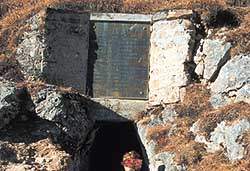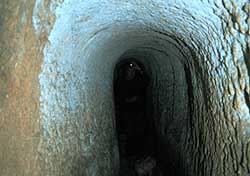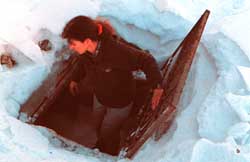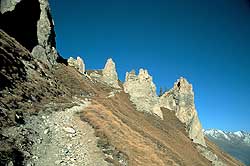|
Il traforo Colombano Romean

Il traforo Colombano Romean
o Pertus de Thullie
È una galleria lunga circa 600 m, posta a circa 2000
m di quota, sotto la Cima dei Quattro Denti di Chiomonte, che
serviva a portare l'acqua del Rio Thullie - sul versante a nord
- a Cels e Ramats - sul versante a sud - per l'irrigazione.
I terreni dell'indiritto erano sterili, perciò nel 1504
gli abitanti di Cels e Ramats costituirono un consorzio per
la derivazione dell'acqua dal versante opposto. Ma passarono
più di venti anni prima di trovare una persona disposta
a scavare il tunnel; il 14 ottobre 1526 i lavori di scavo vennero
affidati a Colombano Romean, uno scalpellino originario d Chiomonte
e abitante in Francia.
Venne stabilito che i consorzisti dovevano fornirgli per ogni
mese di lavoro due semine di segale, una certa quantità
di vino, oltre agli attrezzi per lo scavo, punteruoli e scalpelli,
un mantice e una certa quantità di carbone. Dovettero
inoltre costruirgli presso l'imbocco della galleria una capanna
con un letto, una madia, una botte e fornirgli le lanterne per
l'illuminazione.
Il prezzo del lavoro venne fissato in 5 fiorini e 12 soldi per
ogni tesa (= 1,786 metri) scavata nella roccia. Una delle difficoltà
tecniche che dovette affrontare fu quella dell'aerazione dello
scavo, l'aria probabilmente veniva immessa a forza, con dei
tubi di tela - come quelli usati per l'aerazione delle stive
delle navi - collegati a un mantice.
Colombano Romean impiegò circa 7 anni, proseguendo in
media di 20 cm al giorno, ultimando il lavoro nel 1533, e al
termine della sua fatica ricevette una somma di 1600 fiorini,
pari a 320 scudi.
I collegamenti tra l'imbocco della galleria e la frazione Ramats
erano tenuti da un cane, che tutti i giorni faceva la spola
per portare da mangiare allo scalpellino.
La galleria è larga circa un metro e alta circa due,
ma in certi punti molto meno; sono ben visibili i segni dello
scalpello nella roccia e ogni tanto delle nicchie che servivano
per appoggiarvi le lanterne.
Il tunnel è percorribile abbastanza agevolmente in autunno,
quando vi è poca acqua, in circa mezz'ora (assolutamente
indispensabile una torcia elettrica, possibilmente frontale!).
Si raggiunge seguendo il sentiero n. 548 che parte dalla frazione
Ambournet di Exilles (1381 m). All'imbocco del Pertus vi è
una lapide in bronzo che ricorda l'ingegnosa opera dello scalpellino
chiomontese.
Gli ultimi metri delle pareti della galleria sono cementati
(ristrutturazione nel 1935); per uscire si sale per una scaletta
e si solleva una grata in ferro (che protegge dalla eventuale
caduta di pietre).
Qui ci si trova nel versante all'inverso, dopo poche centinaia
di metri di sentiero si giunge alle baite di Thullie e in leggera
salita alla Cima dei Quattro Denti, e di qui in discesa al bivio
nei pressi dell'imbocco della galleria.
|
The Colombano Romean
tunnel

The tunnel Colombano Romean or Pertus* de
Thuillie
The tunnel is approximately 600m long and
is situated at about 2000m of altitude under the Peak of the
Four Teeth of Chiomonte. It was used to carry water from the
stream Thuillie, in the northern side of the mountain, to the
hamlets Cels and Ramats, in the southern side to water fields
and meadows.
The lands of the southern side were arid, so in 1504 the inhabitants
of Cels and Ramats joined together in an association for the
supply of water from the opposite side. More than twenty years
passed before they found someone prepared to dig the tunnel.
On 14 October 1526 the digging jobs were granted to Colombano
Romean, a stone cutter born in Chiomonte and living in France.
It was established that the association had to give him two
bushels of rye and some wine every month, together with the
digging tools. Some coal and the lanterns. They built for him
a hut near the entrance of the gallery with a bed, a cupboard
and a cask.

The price of the job was fixed at about 5 florins for every
mile dug. One of the technical difficulties he had to face was
the ventilation of the tunnel. The air was probably brought
in by force using canvas tubes connected to bellows, similar
to those used for the ventilation of ships holds.
Colombano Romean spent approximately 7 years digging an average
of 20cm a day and completing the job by 1533. At the end of
his hard work he received a sum of 1600 florins. The connections
between the entrance of the tunnel and the hamlet of Ramats
were done by a dog that every day carried food to the stone
cutter.
The tunnel is about 1 metre wide and 2 meters high and in some
points much less. It is still possible to see the signs of the
chisel in the rock and the niches that served for the lanterns.
The tunnel is easily accessible in autumn, when there is little
water, and it takes approximately half an hour (it is absolutely
necessary to carry a torch). It can be reached following the
path n. 548 that leaves from the hamlet Ambournet di Exilles
(1381m).
At the entrance of the "Pertus" there is a bronze
plaque that remembers the hard work of the stone cutter from
Chiomonte. The last meters of the walls of the gallery are cemented
(built in 1935). You need to climb a ladder and rise an iron
grate to exit (this protects from the eventual stone fall).
Here you find yourself in the northern side and after some hundreds
meters of path you reach the mountain huts of Thuillie. You
can then climb to the Peak of the Four Teeth and from there
in a descending slope the crossroad near the entrance of the
tunnel.
*in the local dialect "Pertus" means "hole".

|